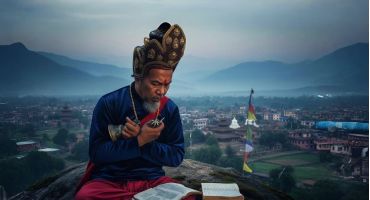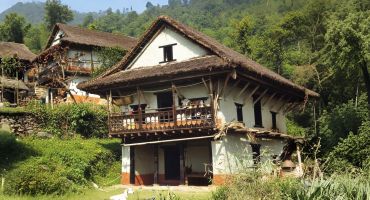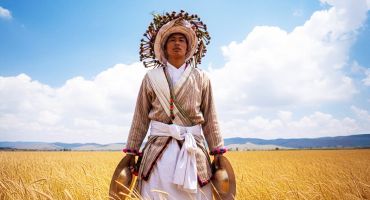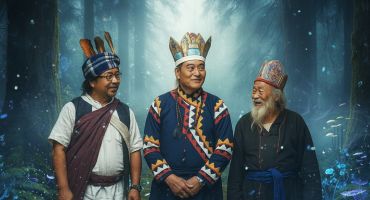“Indigenous people are healthier when their lives include traditional activities and values.” – Dr. Cheryl Currie
For the Limbu people, houses are the dwelling place of ‘life spark/vital force’, guarded by the spirits, who protect all sacred objects constituting the material and spiritual continuity of the family or the clan lineage. It is a domain that in many ways functions as a distinctive entity defining, protecting, and sustaining its members, as a kin-group. It is the responsibility of the head of the house, patriarch or matriarch, to guard the contents, and in particular, their vital life spark. To this end, all Limbu houses must perform the Nahangma appeasement ritual for the vital ‘life spark’ to be restored.
This ‘life spark’ is called Mukuma/Mukkum Sam in the Limbu language. For the Khambus, it is Saya. Mukuma Sam is inherently present in all living beings. This life spark has been passed down from the ancestors through nature and affects and is affected by the surrounding environment because it is the energy that binds and animates all things in the physical world. This applies to the energies and presences of the natural world. Mukuma Sam also empowers, and with unlimited authority, passes on the strength and protective aggression, necessary to operate in the physical realm.
The vital force Saya makes itself felt, not only in the subjective physical or psychic states but also, and in particular, in the social, economic, religious, and political spheres- that is, it finds expression in success, wealth, prestige, and power (Gaenszle) 1
The ritual of Nahangma is performed to restore Mukuma Sam of the family patriarch or matriarch (Tumyahang). A scrutiny of the essence of worship, beyond the spiritual dimension, involved in the concept of Nahangma ritual, shows that it invariably constitutes the domain over which the family’s authority extends and on which its livelihood is based. Asking, through ritual, to reinvigorate the life spark is equal to endorsing the presence of a relationship between the physical world and the ancestral realm. The ritual is an enhancement of this life spark that finds its source through the benevolence of supernatural entities. Only then will humans be able to manage their dominion and govern it by laws promulgated exclusively by themselves.

Nahangma, the divine feminine, possesses several attributes. She is associated with power, beauty, strength, benevolence, and rage. ‘Hang’, or ‘Hangma’ are terms that denote personalities that wield immense authority. Generally, hangma means queen, but it can also mean ‘protector’. In the Limbu myth, the ancient components made possible the events of the first female beings to take up their dwelling in our cosmos. While Yuma, the mother spirit, and her fertility allowed the birth of the first man, Nahangma appears to have been earth and nature itself – an immensely organic, ecological, and conscious whole. She is the one with whom humans would eventually lose touch, affecting their powers to operate in the house and the physical domain.
According to the Limbu myth, Porokmi Yambami Mang, a divine deity, once went to a village called Iwa Hongwana and won the Shot-put (Paklung) competition. After his victory, as he threw the Paklung towards the North, the daughter of Sodhung Lepmuhang, a divine spirit, appeared. She came to be called Nahangma. In the realm of Sawa Yethang, the Eight Limbu Warriors, a fire destroyed various villages. Misfortune had struck, and the land was ravaged by diseases. Sodhung Lepmuhang, asked the youngest son of the Eight Kings, a prince named Seninghang, to go back to the villages and fetch sparkling water, a spear, and three power Shamans. On the way back, as he was playing with the spear, he suddenly started to tremble and went into a state of trance. Anyone who came to wield that spear would astonishingly start to tremble. Upon divination by the Shamans, they came to know that Nahangma was a warrior divinity and she was the one who had to be worshipped to avoid all calamities. She came to be called Khambutling Nahangma, and the Eights Kings started to worship her.
Armed with weapons, Nahangma resides in a snowy realm called Chotlung. Her realm is bright and high, where millions of springs converge to a single point called Sam Lamdoma. Here, there is an unending expanse of blooming flowers, each spiritually connected to a human in the material world. It is a life’s vegetable-twin, its double, its external soul, its flower soul, Phungsam (Sagant) 2. These flowers are the twin soul of humans that adorn the realm of their ancestors. As long as the flower blooms, its physical human twin will have the strength and good health. If it withers, the risk of misfortune or sickness increases. These flowers that live in the shadow of Nahangma’s kingdom must always stay blooming so that an individual’s Mukuma Sam is at its highest capacity and has a strong connection with the ancestral world.
Traditionally, the head of the house, Tumyahang, offers a sacrifice to Nahangma twice a year, once at the beginning of the ascending season (Ubhauli) and once at the beginning of the descending season (Udhauli). This ritual is performed by Limbu shamans like the Phedangma, Samba, and Yeba, with the Tumyahang beside him. The ritual starts in the afternoon and could easily take more than a few hours. An altar will be created in the fields below the house with an offering to Saba, the divine monkey spirit. The monkey spirit is impulsive and will attack the prey instinctively. Over thousands of years of irreconcilable differences between humans and their ancient brethren, the human officiant will try to appease the monkey spirit with offerings and sacrifice. Other divine entities, like the spirit of the forest (Tampungma), and the spirit of the Waters (Warokma), will be consoled by offering a rooster or an egg. The offerings will act like a symbolic fortress for protection against their arrival at the Nahangma altar (Laso) later on. When the temporary altar for the wild spirits is dismantled, the path is blocked, Lam Sakma, to the house.
When dusk sets in, the officiant will have to make offerings to Yuma. In Limbu culture’s oral narrative, Yuma, the primordial mother spirit, and Nahangma are perennial antagonists. Yuma could get jealous of Nagangma, and only the offering of sacrifices has the power to pacify her momentarily. The officiant intones the Limbu ritual speech (Mundhum). Spiritual masters and their invisible energies are invoked. The Limbus consider all neighbouring territories as power places, whose positive connotation derives from their conceptual association with the spatial categories of the hills, rivers, fields, and forests. The Mundhum is recited to honour a series of geographical locations, describing an ideal circular route of all cardinal directions. In the end, the central pillar of the house (Hangsitlang), transforms into the centre of the ritual, and the physical world.

Inside, an altar (Laso) has been created in honour of Nahangma. A bed of wild banana leaves is spread out with rice grains over it, and a brass container filled with water, millet, yeast, ginger, and salt. Among other items, there are weapons of the head of the house, which are the same as those of Nahangma- the bow and the sword/Khukuri. During the Mundhum recitation, the officiant constantly holds the sword or Khukuri. Sodhung Lepmuhang is first invoked. Then, the ten founding kings, and the eight warriors are all summoned to the altar of Nahangma.
While performing Nahangma, the Phedangma pleads to the almighty god for the energy, success, prosperity, and longevity of the benefactor and the whole family. Narrative stories are recited saying, thang tithing- tithing, thang yeppit-yeppit, thang wechcha-wechcha (Limbu phrases meaning- getting high-up, up with energy, up with prosperity) along with physical gestures and performances. (Limbu)3
The officiant takes a cosmic journey to Sam Lamdoma, the expanse of flowers to capture the lost ‘life sparks’. In this particular traditional domain, all the principles of the rite have their legitimacy. All the objects presented play their part in the conceptual structuring of the ritual, not only with the explicit purpose of transforming the entire physical dwelling into an altar but also with the intent of transposing divinations into responses from the otherworld. The officiant holds a red rooster, one that has been raised for at least a few years by the family. The red rooster is supposed to channel invisible energy and deliver a message through a fixed and precise liturgy directed to the tutelary spirits and vice versa. The rooster is placed on the left and right shoulders of the Tumyahang briefly.
A tremendous blow of a wooden stick strikes the back of the rooster. A few drops of its blood must drip upon the banana leaves, through its beak. Only then has the offering will have been accepted by Nahangma. Few of its feathers are plucked out and placed upon the altar. The officiant will wrap a white turban around the Tumyahang’s head, and while wrapping it, he places a feather upon the turban. The officiant will then hold the sword, and the Tumyahang near him will carry the bow and arrow. Tumyahang must now howl and stamp his feet on the ground to imitate the ancient warriors of his clan. This gesture is repeated a few times. The Shaman will proclaim that his ‘life spark’ has been restored. His head has been raised, and all misfortunes have been averted.

At this stage of the Nahangma ritual, besides recalling Mukuma Sam, the offerings to Nahangma are also made to honour her virtues. Although the Limbu community is founded securely on some hegemony of the male lineage, this ritual inclines towards bearing witness to the existence of a mythical matriarch. Nahangma, with traditional masculine virtues, in their widest meaning, emerges and takes over Limbu domestic hierarchy with ritualistic authority. For the Limbu people, the Nahangma ritual, besides constituting the premise for a reintegration of the life spark/vital force, transforms the house from a static residence to a repository of traditions generated by the cultural schemes, history, and practices of its inhabitants.
References:
1. Gaenszle, Martin.(2000): Origins and Migrations: Kinship, Mythology and Ethnic Identity among the Mewahand Rai of East Nepal.
2. Sagant, Philippe.(1981): La tête haute : maison, rituel et politique au Népal oriental.
3. Limbu, RK.(20125): Limbu Indigenous Culture and Knowledge





Leave a Reply